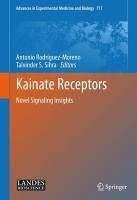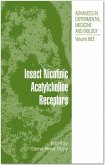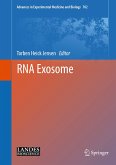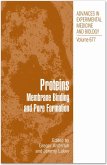Kainate Receptors (eBook, PDF)
Novel Signaling Insights
Redaktion: Rodriguez-Moreno, Antonio; Sihra, Talvinder S.
72,95 €
72,95 €
inkl. MwSt.
Sofort per Download lieferbar

36 °P sammeln
72,95 €
Als Download kaufen

72,95 €
inkl. MwSt.
Sofort per Download lieferbar

36 °P sammeln
Jetzt verschenken
Alle Infos zum eBook verschenken
72,95 €
inkl. MwSt.
Sofort per Download lieferbar
Alle Infos zum eBook verschenken

36 °P sammeln
Kainate Receptors (eBook, PDF)
Novel Signaling Insights
Redaktion: Rodriguez-Moreno, Antonio; Sihra, Talvinder S.
- Format: PDF
- Merkliste
- Auf die Merkliste
- Bewerten Bewerten
- Teilen
- Produkt teilen
- Produkterinnerung
- Produkterinnerung

Bitte loggen Sie sich zunächst in Ihr Kundenkonto ein oder registrieren Sie sich bei
bücher.de, um das eBook-Abo tolino select nutzen zu können.
Hier können Sie sich einloggen
Hier können Sie sich einloggen
Sie sind bereits eingeloggt. Klicken Sie auf 2. tolino select Abo, um fortzufahren.

Bitte loggen Sie sich zunächst in Ihr Kundenkonto ein oder registrieren Sie sich bei bücher.de, um das eBook-Abo tolino select nutzen zu können.
This volume critically examines the functional actions of the kainate-type glutamate receptors (KARs). Following on from the larger body of work on the NMDA- and AMPA-type ionotropic glutamate receptors (GluRs), studies with KARs have consistently thrown up exceptions to general rules about synaptic modulation. Contributors herein provide an insight to the idiosyncracies that now almost typify the KAR field. The fascinating insights provided in this volume serve to encourage searching mechanistic questions.
- Geräte: PC
- ohne Kopierschutz
- eBook Hilfe
- Größe: 5.59MB
Andere Kunden interessierten sich auch für
![Insect Nicotinic Acetylcholine Receptors (eBook, PDF) Insect Nicotinic Acetylcholine Receptors (eBook, PDF)]() Insect Nicotinic Acetylcholine Receptors (eBook, PDF)112,95 €
Insect Nicotinic Acetylcholine Receptors (eBook, PDF)112,95 €![RNA Exosome (eBook, PDF) RNA Exosome (eBook, PDF)]() RNA Exosome (eBook, PDF)112,95 €
RNA Exosome (eBook, PDF)112,95 €![Proteins (eBook, PDF) Proteins (eBook, PDF)]() Proteins (eBook, PDF)144,95 €
Proteins (eBook, PDF)144,95 €![Principles of Bacterial Detection: Biosensors, Recognition Receptors and Microsystems (eBook, PDF) Principles of Bacterial Detection: Biosensors, Recognition Receptors and Microsystems (eBook, PDF)]() Principles of Bacterial Detection: Biosensors, Recognition Receptors and Microsystems (eBook, PDF)175,95 €
Principles of Bacterial Detection: Biosensors, Recognition Receptors and Microsystems (eBook, PDF)175,95 €![Mast Cell Biology (eBook, PDF) Mast Cell Biology (eBook, PDF)]() Mast Cell Biology (eBook, PDF)160,95 €
Mast Cell Biology (eBook, PDF)160,95 €![Recognition Receptors in Biosensors (eBook, PDF) Recognition Receptors in Biosensors (eBook, PDF)]() Recognition Receptors in Biosensors (eBook, PDF)160,95 €
Recognition Receptors in Biosensors (eBook, PDF)160,95 €![Molecular Basis of Insulin Action (eBook, PDF) Molecular Basis of Insulin Action (eBook, PDF)]() Michael P. CzechMolecular Basis of Insulin Action (eBook, PDF)72,95 €
Michael P. CzechMolecular Basis of Insulin Action (eBook, PDF)72,95 €-
-
-
This volume critically examines the functional actions of the kainate-type glutamate receptors (KARs). Following on from the larger body of work on the NMDA- and AMPA-type ionotropic glutamate receptors (GluRs), studies with KARs have consistently thrown up exceptions to general rules about synaptic modulation. Contributors herein provide an insight to the idiosyncracies that now almost typify the KAR field. The fascinating insights provided in this volume serve to encourage searching mechanistic questions.
Dieser Download kann aus rechtlichen Gründen nur mit Rechnungsadresse in A, B, BG, CY, CZ, D, DK, EW, E, FIN, F, GR, HR, H, IRL, I, LT, L, LR, M, NL, PL, P, R, S, SLO, SK ausgeliefert werden.
Produktdetails
- Produktdetails
- Verlag: Springer US
- Seitenzahl: 131
- Erscheinungstermin: 28. Juni 2011
- Englisch
- ISBN-13: 9781441995575
- Artikelnr.: 43729678
- Verlag: Springer US
- Seitenzahl: 131
- Erscheinungstermin: 28. Juni 2011
- Englisch
- ISBN-13: 9781441995575
- Artikelnr.: 43729678
- Herstellerkennzeichnung Die Herstellerinformationen sind derzeit nicht verfügbar.
ANTO NIO RODRIGUEZ¿MORENO is Associate Professor and Head of the Cellular Neuroscience and Plasticity Laboratory at the University Pablo de Olavide, in Seville, Spain. His main research interests include the study of the mechanisms of synaptic plasticity in cortex and hippocampus and the physiology of glutamate receptors of the NMDA and kainate type. He is a member of the Federation of European Neuroscience Societies (FENS) and the Society for Neuroscience (SFN). Following a degree in Biological Sciences at the University of Seville, Dr. Rodriguez¿Moreno received his PhD degree in Neurobiology and Molecular Biology from Cajal Institute and the University Automous of Madrid in Madrid, Spain. During a first postdoc at the University Pablo de Olavide, in Seville (Spain) he studied the mechanisms of learning and memory in awake animals. This was followed by a postdoctoral stay at University College London (UK) where he investigated the actions of kainate receptors using synaptosomes and brain slices. During a third postdoc at University of Oxford, he started to study the mechanisms of brain plasticity processes. TAL VINDER S. SIHRA is a Reader in Cellular and Molecular Neuroscience, and Teaching Lead in the Department of Neuroscience, Physiology and Pharmacology at University College London (UCL) UK. His main research interests are in the elucidation and characterisation of presynaptic receptors and downstream signaling pathways involved in the modulation of neurotransmitter release. Pursuant to an undergraduate degree in Biochemistry and Physiology from the University of Sheffield, UK, he completed his PhD (Biochemistry) in 1985 at the University of Dundee, Scotland, where he initiated his studies looking at the mechanisms underlying amino acid neurotransmitter release. He extended these studies at the Rockefeller University,New York, USA, in the laboratory of Professor Paul Greengard, Nobel Laureate in Medicine (2000), looking at the role of protein phosphorylation in presynaptic function and plasticity. In 1993, he obtained a faculty position at the University of London (Royal Free Hospital School of Medicine), and continued thereafter at UCL. Dr. Sihra is a member of the Biochemical Society (UK) and currently on the Signalling theme panel for the Society. He is a member of the Society of Neuroscience and former editor of the British Journal of Pharmacology. TAL VINDER S. SIHRA is a Reader in Cellular and Molecular Neuroscience, and Teaching Lead in the Department of Neuroscience, Physiology and Pharmacology at University College London (UCL) UK. His main research interests are in the elucidation and characterisation of presynaptic receptors and downstream signaling pathways involved in the modulation of neurotransmitter release. Pursuant to an undergraduate degree in Biochemistry and Physiology from the University of Sheffield, UK, he completed his PhD (Biochemistry) in 1985 at the University of Dundee, Scotland, where he initiated his studies looking at the mechanisms underlying amino acid neurotransmitter release. He extended these studies at the Rockefeller University, New York, USA, in the laboratory of Professor Paul Greengard, Nobel Laureate in Medicine (2000), looking at the role of protein phosphorylation in presynaptic function and plasticity. In 1993, he obtained a faculty position at the University of London (Royal Free Hospital School of Medicine), and continued thereafter at UCL. Dr. Sihra is a member of the Biochemical Society (UK) and currently on the Signalling theme panel for the Society. He is a member of the Society of Neuroscience and former editor of the British Journal of Pharmacology. TAL VINDER S. SIHRA is a Reader in Cellular and Molecular Neuroscience, and Teaching Lead in the Department ofNeuroscience, Physiology and Pharmacology at University College London (UCL) UK. His main research interests are in the elucidation and characterisation of presynaptic receptors and downstream signaling pathways involved in the modulation of neurotransmitter release. Pursuant to an undergraduate degree in Biochemistry and Physiology from the University of Sheffield, UK, he completed his PhD (Biochemistry) in 1985 at the University of Dundee, Scotland, where he initiated his studies looking at the mechanisms underlying amino acid neurotransmitter release. He extended these studies at the Rockefeller University, New York, USA, in the laboratory of Professor Paul Greengard, Nobel Laureate in Medicine (2000), looking at the role of protein phosphorylation in presynaptic function and plasticity. In 1993, he obtained a faculty position at the University of London (Royal Free Hospital School of Medicine), and continued thereafter at UCL. Dr. Sihra is a member of the Biochemical Society (UK) and currently on the Signalling theme panel for the Society. He is a member of the Society of Neuroscience and former editor of the British Journal of Pharmacology.
Metabotropic Actions of Kainate Receptors in the Control of GABA Release.- In the Developing Hippocampus Kainate Receptors Control the Release of GABA from Mossy Fiber Terminals via a Metabotropic Type of Action.- Localization and Functions of Kainate Receptors in the Basal Ganglia.- Metabotropic Actions of Kainate Receptors in the Control of Glutamate Release in the Hippocampus.- Metabotropic Actions of Kainate Receptors in the Regulation of IsAHP and Excitability in CA1 Pyramidal Cells.- Kainate Receptors with a Metabotropic Signature Enhance Hippocampal Excitability by Regulating the Slow After Hyperpolarization in CA3 Pyramidal Neurons.- Metabotropic Actions of Kainate Receptors in Dorsal Root Ganglion Cells.- Role of Kainate Receptors in Network Activity during Development.- Kainate Receptor Modulation by Sodium and Chloride.- BTB Kelch Proteins and Ubiquitination of Kainate Receptors
Metabotropic Actions of Kainate Receptors in the Control of GABA Release.- In the Developing Hippocampus Kainate Receptors Control the Release of GABA from Mossy Fiber Terminals via a Metabotropic Type of Action.- Localization and Functions of Kainate Receptors in the Basal Ganglia.- Metabotropic Actions of Kainate Receptors in the Control of Glutamate Release in the Hippocampus.- Metabotropic Actions of Kainate Receptors in the Regulation of IsAHP and Excitability in CA1 Pyramidal Cells.- Kainate Receptors with a Metabotropic Signature Enhance Hippocampal Excitability by Regulating the Slow After Hyperpolarization in CA3 Pyramidal Neurons.- Metabotropic Actions of Kainate Receptors in Dorsal Root Ganglion Cells.- Role of Kainate Receptors in Network Activity during Development.- Kainate Receptor Modulation by Sodium and Chloride.- BTB Kelch Proteins and Ubiquitination of Kainate Receptors







